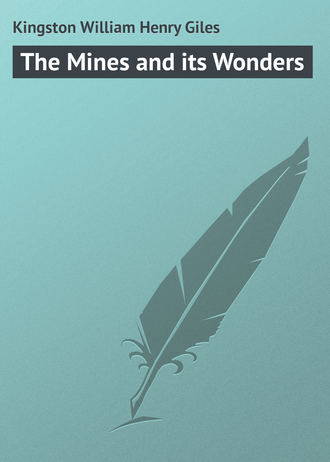 полная версия
полная версияThe Mines and its Wonders
Some few years ago, as the engineer and several men of the mine of Méons were descending standing in a tub, each with a lamp in one hand, and holding on to the chain above him with the other, a couple of tubs loaded with coal unhooked theirs, which fell to the bottom. Providentially they had not relaxed their grasp of the chain above their heads, and at once letting go their lamps and desperately seizing it with both hands, they continued their descent, though huge lumps of coal were falling out of the tubs above them. Wonderful to relate, they reached the bottom in safety. On another occasion, while the same engineer was ascending in a tub, it was upset in consequence of the engineman raising the rope too suddenly. The engineer hanging on by one leg, with his head downwards was hoisted a height of forty yards, before the alarm was given and he was lowered to the bottom.
In the same mine, another engineer, while descending in a tub, had his clothes caught by a strut which projected from the side of the pit; he here hung suspended while his companions continued to descend, terrified for his safety and alarmed for their own, as should he fall, they expected to be crushed by his weight. In vain they shouted for assistance, the men at the top of the pit having gone out of hearing. Not until they reached the bottom could they send any aid to their companion. He in the meantime had been vainly endeavouring to find some support so as to relieve the strain on his torn garments, which threatened every instant to give way. After hanging thus for twenty minutes, he was at length set free, but no sooner was he received in the tub than he became insensible. A severe illness of long duration followed, but he ultimately recovered, though he ever afterwards preferred going down the ladders to descending in a tub. Anecdotes of the same description could be given without end. Most accidents of this character have ended fatally. To avoid them various inventions have been devised, one of which is known as the mounting machine, or man-engine. It consists of two parallel rods, furnished at equal distances with steps, while one is raised to a certain height the other is lowered to the same distance. While the movement of the crank is on its turning point, the miner passes from the step on which he is standing to the opposite step of the other. As they are constantly moving up and down, his next step is back again to the rod he had before left, which rising a few feet, he is able to step back to the other, just as it, having gone down, is once more ascending; and thus he reaches the top with little fatigue.
Far superior to this mode of ascending or descending are the safety-cages introduced of late years, which have guides the whole length of the shaft, and bonnets or roofs to protect the heads of the men within. They are made with several stages, in which either the tubs or waggons can be placed, or where the miners can stand or sit. If a rope breaks, a spring placed above the cage and kept taut by the tension of the rope, is set free, and acts upon a double clutch made of the best tempered steel. This catch or wedge falls between the wooden guide and a part of the cage, and brings the latter immediately to a stand-still. By this means numberless accidents have been prevented. The man-engines which have been described are dangerous for novices, for should a person stop at the wrong time, he may be hurled to the bottom, or crushed at the return stroke.
One of the most frequent accidents to which miners are exposed arises from an outbreak of fire-damp. To avoid this, various safety-lamps have been invented. The most celebrated is that known as Sir Humphrey Davy’s lamp. The flame is enclosed in a fine wire gauze, through which, under ordinary circumstances, the gas cannot penetrate. There are other lamps in use constructed on the same principle, but superior in some respects. Too often, however, the miners open them at some fatal moment, or enter the mine, against orders, with naked candles. Still, by means of these lamps, when properly employed, many accidents have been prevented. Another invention exists by which a person can enter in the midst of impure air. The apparatus was devised by Monsieur Kouquayrol, a French engineer. It consists of a reservoir made of sheet iron, into which the air is forced, and, by an ingeniously contrived pump, is secured like a knapsack to a man’s back, and the air is conveyed by means of a tube to the mouth of a nose, and thus into the lungs at the ordinary pressure, while a small external valve allows of the escape of the air after it has been respired.
A still more simple apparatus has been invented by Monsieur Galibert. The system for condensing the pure air is more perfect, while the reservoir consists of a well-prepared goat-skin, which, when inflated, a man can with ease carry on his back. It is furnished with a similar contrivance to the former, a tube passing from the reservoir to the mouth, while the nostrils are compressed, the eyes and head are protected, so that provided with it, a person may exist for a quarter of an hour in the foulest atmosphere, or in the midst of dense smoke. Although the metal miner is subjected to fewer accidents than are his brethren working in coal mines, the atmosphere in the former is far more destructive to human life. In lead mines, the duration of life averages scarcely more than thirty-two years, and in those containing arsenical pyrites or quicksilver ores, the average is still lower. Before the use of gunpowder in underground operations, the rocks containing the ore were attacked with fire, indeed the practice is still retained in some countries. Huge wood fires are made up against the face of the rock, which becomes shattered and traversed by cracks, and when cooled, it is easily detached with a pick or fork. Of late years, however, machines have been devised for boring or breaking the rock. Some form a hole by the continuous motion of a rotating drill, others by means of intermittent blows. One of these rock-boring machines, manufactured by Messrs Turner, of Ipswich, performs its work by a combination of both these operations. By the employment of these machines, the formation of the tunnel under Mount Cenis was greatly facilitated. An example has already been given of the way in which people have been saved from the effects of inundations in mines, others have been dug out when buried by the fall of roofs, but almost countless are the numbers who have perished from other causes, for if the first have destroyed their hundreds, the fire-damp in coal mines has proved the destruction of thousands. It was at one time considered right every night to provoke an explosion by lighting the fire-damp in order that the working stalls should be accessible next morning. The man who performed this dangerous operation wore a thick covering of wool or leather, his face was protected, and his head was covered by a hood like a monk’s cowl. He crept along the ground, carrying in his hand a long pole with a light at the end of it. He was known in the English mines as the fireman, but in the French he was called either the cannonier, the monk, or the penitent, the latter name being given him from his dress resembling that of certain so-called religious orders in the Romish Church. Too frequently the hapless penitent was destroyed by the explosion he had provoked.
Our two friends, however, might have written several large volumes had they given accounts of even a portion of the interesting matters concerning mines which they gathered up during their long and varied tour.
Mark did not fail to benefit largely by the information he obtained, and he ultimately, with the numerous improvements he introduced, became the proprietor of two of the coal mines in which he had worked in his boyhood, while his young sister, on whom he had had the satisfaction of bestowing a high-class education, refined in mind and manners, became the wife of his friend and fellow-traveller.
The End










